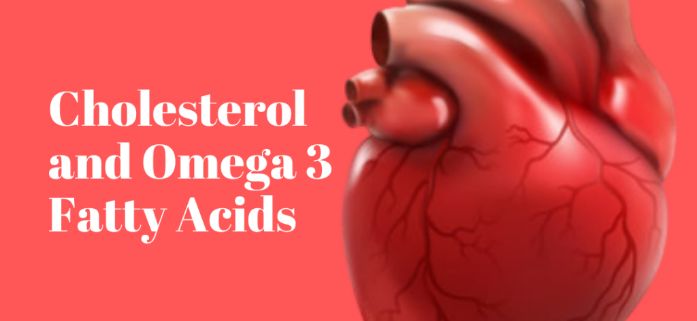Cholesterol and Omega 3 Fatty Acids
Cholesterol is a fatty wax-like substance present in all the cells of the body and it is also in transit in the blood. In fact, to test for the level of cholesterol in the body, you have to do a blood test. Usually, the body produces all the cholesterol it needs. There are occasions where the liver produces cholesterol in response to increased demand of cholesterol in a state of dehydration in the body.
Functions of cholesterol
Cholesterol plays a role in many vital functions of the body. It is a precursor in the production of all sex hormones in the body. It is also involved in the manufacture of bile salts and other substances that help the body to digest food, especially fatty foods. Cholesterol is needed in the production of vitamin D in the skin, when exposed to sunlight. In water therapy, we understand that cholesterol plays a very significant role in water redistribution when the body is dehydrated.
Types of cholesterol
There are two main types of cholesterol that we are interested in here in this article. These are the HDL-cholesterol and the LDL-cholesterol. Cholesterol is not water soluble and therefore it cannot dissolve in and be transported by the blood. It has to bind to lipoproteins before it can be transported in the blood. The two types of lipoproteins that bind cholesterol are low density (LDL) and high density lipoprotein (HDL). When cholesterol is bound to LDL, it is known as ‘bad’ cholesterol and when it is bound to HDL, is referred to as ‘good’ cholesterol.
Low density lipoprotein transports cholesterol to the tissues where it can increase the risk of heart diseases, high blood pressure and stroke. On the other hand, HDL-cholesterol reduces the risk of heart diseases and other complications because it transports cholesterol from the tissues to the liver where it is metabolized, used in the production of bile salts and excreted.
The LDL to HDL ratio is very important. This ratio will determine whether cholesterol will be deposited in the tissues and increase the risk of heart disease or transported to the liver for metabolism and production of bile salts. As we shall see later in this article, the risk of heart disease can be reduced drastically by lowering LDL-cholesterol, while at the same time you raise the HDL-cholesterol. This is what we must have in mind in the treatment of hypercholesterolemia.
Normal Blood Levels of Cholesterol
- Total Cholesterol – less than 200 milligrams/deciliter
- LDL Cholesterol – less than 130 milligrams/deciliter
- HDL Cholesterol – more than 35milligrams/deciliter
- LDL to HDL ratio – less than 4:5.
Hypercholesterolemia
This is a state of excessively high cholesterol in the blood.
An unhealthy lifestyle is by far the commonest cause of high cholesterol in the blood. This lifestyle will include eating unhealthy and ‘dead’ foods such as saturated fats in some types of meat, white flour and its products (baked foods), dairy products, chocolates, deep fries and fast foods cooked with bad fats. Sedentary lifestyle and lack of exercise lead to a lower HDL (good) cholesterol. Another habit which lowers HDL – cholesterol is smoking. It also increases LDL (bad) cholesterol. Hypercholesterolemia may be inherited and some medications may also cause it.
Risk factors of hypercholesterolemia are age, race, heredity, obesity, cigarette smoking etc.
Omega 3 Fatty Acids
These are polyunsaturated fatty acids that are widely distributed in nature and they play very important roles in human diet and the metabolic processes that go on in the human body.
There are three types of omega 3 fatty acids that are commonly involved in the workings of the human being and these are; a-linolenic acid (ALA) which is usually sourced from plants and eicosapentaenoic acid (EPA) and docosahexaenoic acid (DHA), both of which are found in cold water fish. Flaxseed is the commonest plant source of ALA. It can also be found in walnut, almonds and hemp seed. Sources of omega 3 fatty acids, EPA and DHA are cold water fish like salmon, tuna, mackerel and sardines.
These fatty acids are not synthesized in the human body, so all that mankind needs has to be sourced from his diet. Omega 3 fatty acids, EPA and DHA are the forms in which fatty acids are utilized in the body. However, omega 3 fatty acid, ALA from plant sources is usually converted to the usable EPA and DHA in the body.
Functions of omega 3 Fatty Acids
Omega 3 fatty acids lower total cholesterol, LDL (bad) cholesterol and they increase HDL (good) cholesterol. By so doing, they tilt the LDL to HDL ratio in favor of HDL thereby reducing the risk of heart diseases. These fatty acids, whether from plants or fish oils, reduce the ability of platelets to stick together and thus prevent clot formation. When platelets stick together, (aggregate), they release potent compounds that promote the formation of atherosclerotic plaques. In other words, omega 3 fatty acids prevent the sticking together of platelets and the formation of atherosclerosis. Platelet aggregation can also form blood clots that can block small arteries in the heart or the brain where they give rise to heart attack and stroke respectively. This action of the platelets can be prevented by omega 3 fatty acids.
Recommendations
To be certain that your heart and arteries (coronary, cerebral, peripheral and others) are cleansed of artherosclerotic plaques and to prevent heart diseases you have to make the consumption of omega 3 fatty acid-rich foods a regular part of your diet. At the risk of sounding repetitive, omega 3 fatty acid-rich foods are cold water fish: salmon, tuna, mackerel, sardine and such plant foods as flaxseed, flaxseed oil, walnut, almonds and hemp seed. There are also supplements of these fish oils and flaxseed oil that can be bought from Health Food Shops to add to these natural products.




Leave a Reply
Want to join the discussion?Feel free to contribute!